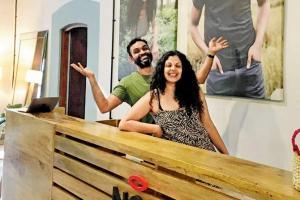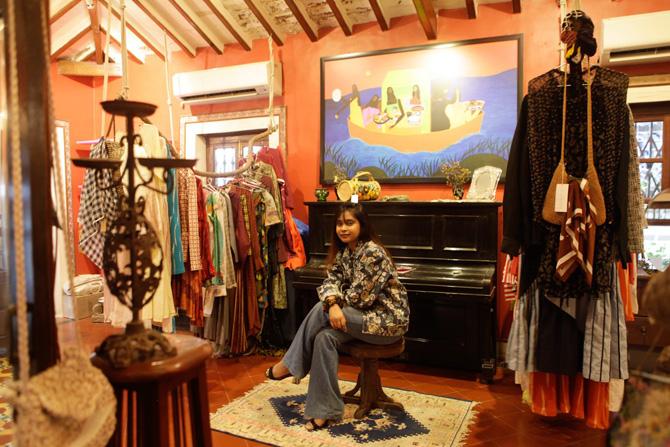With climate change becoming drawing-room conversation, here's how some people in the city are looking good while feeling good about it too

.
At the recently concluded Paris Fashion Week Spring-Summer 2020 showcase, Stella McCartney launched her most sustainable collection yet. Seventy-five per cent of the line was made from zero-impact fabrics, the remaining from organic cotton or upcycled denims. In September, Gucci declared itself as carbon neutral in its operations and supply chain. Both are among 150 brands—a list that includes Hermes, Burberry and Ralph Lauren—that have signed the Fashion Pact initiative led by French luxury brand Kering, that requires signatories to commit to reduce their environmental impact.
ADVERTISEMENT
Fast fashion has contributed not just to environmental damage but modern-day slavery too, as the collapse of Dhaka's Rana Plaza highlighted. And so, this turn for the better is welcome. But how can everyday people support this newly woke industry? Turns out, it's quite simple.

Stage 3
By Sanchit Baweja
Pre-owned clothes for renting and buying
Prices start at: Rs 2500
Order at: www.stage3.co
1. Support sustainable brands
While fashion giants are adapting themselves to survive in the Age of Greta Thunberg, younger, independent fashion houses incorporate sustainability upfront in their DNA. Like No Nasties. When he launched the T-shirt brand in 2011, Apurva Kothari, now 44, founded it as an organic and fair trade company right off the bat. The techie who had returned from the US, was disturbed by the idea that "farmers in places that were just an overnight train ride from Mumbai" were committing suicide.
"Cotton covers about five per cent of India's farmlands, but accounts for 50 per cent of pesticide use. Organic cotton is water efficient and does not use chemical fertilisers. Our supply chain is also organic. We use natural, water-based dyes and cotton bags and reusable boxes for packaging. Last year, we introduced a scheme through which we plant one tree in our grove in Koraput, Odisha, for every product you buy."
No Nasties is also a Fairtrade licensed brand, which means it is committed to ensure fairer conditions for cotton producers, sustainable livelihood and a premium that enables co-operatives to fund projects that benefit the local community. "It helps reduce production costs for the farmers, increase their income and helps them get out of debt," Kothari says.
While cotton remains one of the most used textiles on this planet, aside from polyester, a movement that's fast evolving is that of using fabric made from food waste and crop residue of pineapple, sugarcane and banana.

No Nasties
By Apurva Kothari and Shweta Delwala
Pesticide-free organic cotton clothes
Tees at: Rs 1,200; jumpsuits at: Rs 7,000; kidswear at: Rs 1,500 onwards
Order at: www.nonasties.in
Mumbai-based B Label manufactures hemp fabric using a process developed in collaboration with IIT Delhi. By virtue of hemp being a carbon negative crop, B Label is a carbon negative company. Chirag Tekchandaney, co-founder and director, points out that hemp is among the fastest growing crops that takes anywhere between 90 and 120 days to grow. "It needs little water and has properties of soil remediation. It also has eight times the tensile strength of cotton. Which means it lasts longer and the more you wash, the smoother it gets."
Tekchandaney says almost all the buttons on their shirts are made from mother of pearl or cotton husk. "When we deliver it, the packaging is also reusable and sustainable."
While he avoids commenting on the longevity of B Label's products since it depends on personal use, he says he continues to wear a B Label shirt from 2014 to all his important meetings.
This helps counter the take-make-dispose system of the fashion industry that, according to a 2017 Ellen MacArthur Foundation report, creates annual greenhouse gas emissions of 1.2 billion tonnes. That's more than all maritime shipping and international flights put together. The report also says that "every second, an equivalent of one garbage truck of textiles is landfilled or burned". Among the solutions it suggests, include recycling, reselling or renting clothes.
2. Where to buy/rent pre-loved clothes
Kanika Karvinkop, 32, founded No Borders, a concept store at James Ferreira's heritage residence in Khotachiwadi, with the aim of showcasing the work of young and contemporary designers. She says half her stock of clothes and accessories is vintage. "Every time I travel overseas, I tend to shop vintage. At some point, I noticed there weren't a lot of options to do this in India. When we did a pop up [at the same place where the store is now] and managed to sell out almost everything, I realised there's a market for this. I opened the store in April 2018." Among the curated collection are YSL jackets, bags from 1950s Pakistan and purses from 1920s Spain. Karvinkop says her vintage products are generally priced under Rs 10,000.
Like Karvinkop, Divya Saini, 29, also discovered vintage during one of her overseas trips and is bullish on the trend. "Vintage fashion has been around in many parts of the world, but marginally appreciated in India. In my opinion, it is going to blow up here in the next couple of years. People want something fresh and exclusive. So, we will have to keep up with the curation."

B Label
By Chirag Tekchandaney
Menswear in hemp fabric
Shirts at: Rs 2,290; jackets for: Rs 4,490
Order at: www.blabel.in
Saini runs Bodements, an Instagram store that does pop-ups in Paris—where her partner Martin Letellier holds fort—and Mumbai. "At the moment, we offer some selective vintage creations from the late '60s to early 2000s, mostly from French designers or brands," she says adding, "We may be catering to a niche market, but our aim is to open out to a wider audience. So we've been working on new connections and relationships to introduce some Italian designers to our catalogue in the coming months."
About 80 per cent of Bodements' inventory includes shirts and jackets since "they're most easily purchaseable without having to try them on". Saini says you can also sell anything that's vintage or pre-loved that matches their aesthetics and quality check. Luxury accessories are more popular, but they also accept any kind of clothing and footwear.
On a more commercial scale, there are platforms such as Etashee that aims to be the "OLX of fashion", Flyrobe and STAGE 3 that power the fashion re-commerce segment. With over 50,000 registered users, Stage 3's idea is to make aspirational fashion affordable. It's 29-year-old co-founder and chief business officer Sanchit Baweja pegs the fashion re-commerce market in India at anywhere between $3 million and $4 million (R21 crores to R28 crores). While the segment in general and Stage 3, specifically, haven't penetrated dailywear like in the West, there's a need they fulfil during festive and wedding seasons.

No borders
By Kanika Karvinkop
Vintage pieces: Under Rs 10,000
Order at: noborders.in
Pic/ Ashish Raje
"We buy inventories from designers such as Shantanu-Nikhil, Manish Malhotra, Arpita Mehta and Anushree Reddy in bulk and rent it at 10 per cent of the MRP," he says. Younger designers—Stage 3 stocks over 200 in total—hand out their inventory on a revenue-share basis. While anarkali gowns, crop tops and lehengas are among the bestsellers, Stage 3 is now looking to increase its menswear and everyday wear catalogue to include maternity wear, formal work wear and children's clothes to prepare for a time when the idea of renting and re-using clothes gets normalised in India.
While supporting sustainable brands, buying vintage and renting clothes is eco-friendly, using your clothes for longer and changing your laundry routine can go a long way.
3. How to give your laundry routine an eco-friendly update

Bodements
By Divya Saini
Rs 2,500 onwards
Order at: @bodements_
The easiest way to increase the life of your clothes is, of course, by ditching the washing machine. According to Fashion Revolution, a non-profit global movement that campaigns for greater transparency in the fashion supply chain, how we wash and care for a garment can contribute up to 25 per cent to its carbon footprint. Both Kothari and Tekchandaney advocate the practice of being aware of where your clothes come from. Kothari says: "You're keen on knowing what goes into your food, you should also be aware of what goes into your clothes." Tekchandaney adds: "Read washcare notes on your garment and follow them. Ideally, wash them by hand and dry them on a line like we used to not too long ago, instead of running a lot in the washing machine."
If you happen to be using a machine, though, avoid running it till you have a full lot. By some estimates, each washload releases up to 7 lakh microplastics into the sewage system. These microplastics come mostly from synthetic clothing. So, while you continue opting for natural fibres and reduce the use of the washing machine, products such as Guppyfriend washing bag (available online) that catches microplastics inside your machine can help to some extent.
There is no easy answer to how to save the world; some may suggest the battle is already lost. But, as Jonathan Franzen writes in his New Yorker piece once you accept that we've lost the war, other kinds of action take on greater meaning. Perhaps then, a single garment may well be the only thing we can control.
$3mn- $4mn
Value of the fashion re-commerce market in India
Catch up on all the latest Mumbai news, crime news, current affairs, and also a complete guide on Mumbai from food to things to do and events across the city here. Also download the new mid-day Android and iOS apps to get latest updates
 Subscribe today by clicking the link and stay updated with the latest news!" Click here!
Subscribe today by clicking the link and stay updated with the latest news!" Click here!







